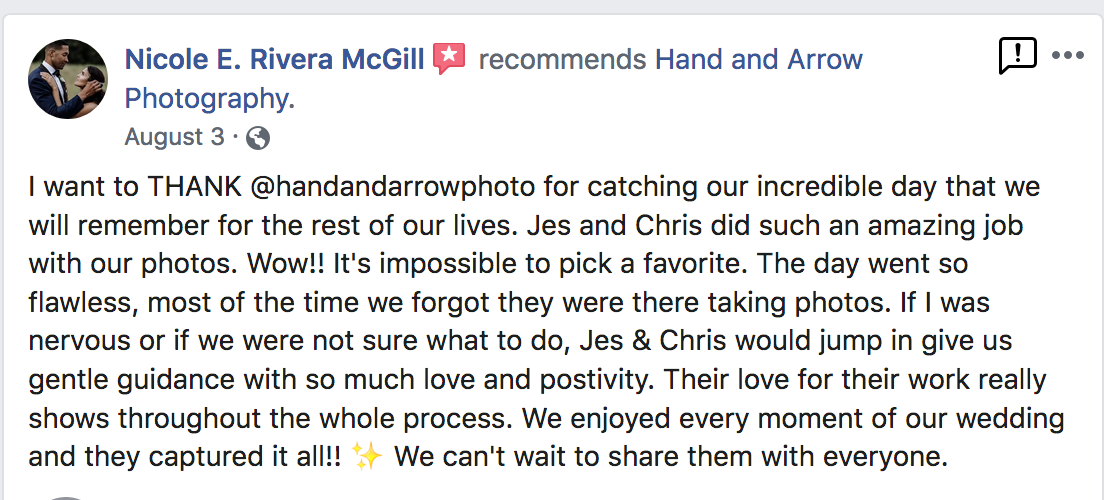Last Updated: February 14th, 2020
Your “reputation” as a professional photographer often feels like an abstract and intangible thing. When we reflect on our own reputation as photographers (Hand & Arrow Photography) and educators here on Formed From Light – we aim to measure how we are doing based on our bookings, client feedback, and general buzz we hear both online and in our real world communities.
There have been a few times over the past year that we were caught off guard by our own notoriety. We’ve showed up at brand new wedding venues to work with people we’ve never heard of – only to be told by a coordinator or wedding guest that they “love our work!” We have a good reputation, and aim to keep it that way!
As we strive to continue growing awareness of our quality brands, we wanted to take a little bit of time and share some of our own thoughts on how you can build a great reputation, too!
The life of a professional photographer is as cool as it is challenging. The benefits of having a positive reputation include more income, online buzz, and even the potential to get recognized locally and international for your work.
What is a “great” reputation anyways?
Before we dive into our 10 steps to build a great reputation, we want to talk briefly about why it matters.
Having a solid reputation means that you (and your work) is well liked. By being liked, you are more likely to bring in new clients, and as a result are able to continue sustaining your work as a pro photographer. In our little world, this is one of the most important aspects of running a business – being able to bring in money so we can continue to invest in gear, pay our bills, and do the things we want to do.
More than money, seeing the fruits of a good reputation can also bring a lot of personal and professional satisfaction.
Last year, we photographed the wedding of Nathan Pyle, well known for his illustrations and pretty much “online famous” for his Strange Planet series of comics. We were excited for this opportunity, and after posting a few shots on social media, the increase in followers, overwhelmingly positive response to our work, and influx of inquiries to book with us all served as good “reputation” points.
Seeing our reputation grow over the years as we continue to hone our craft, book new clients, and get unique opportunities has been really quite amazing. While there are absolutely struggles during this process of starting a photography business and continuing to grow it, these little moments are great memories to look back on.
10 Steps To Building Your Own Great Reputation as a Photographer

1). Simplify the client experience.
Very early on in our photography careers, our #1 goal was to “book clients at any cost.” This included offering cheap services, driving farther than we would have liked, and so on. During these early stages, we were so focused on getting our bookings, that we didn’t stop to think about our own processes.
We never thought things like…
- Is booking our photography service easy?
- What does it feel like to be a client going through this process?
- How could we make this easier for people?
Over time, we’ve really refined our processes (and continue to do so). Our goal has been to provide much more streamlined and simplified processes from the moment someone first inquires for our service, to booking, to the time they receive their online gallery filled with the images they really wanted!
Some of these changes required spending a little bit of money such as on a service like Honeybook, which helps us to more easily book clients by being able to send & sign contracts online, as well as send & receive payments via credit/debit cards, too!
Other changes just required actually thinking things through a little more. Instead of just sending out an email, we’ve started to re-read our messages to make sure we are being clear and concise.
There are many things you can do to simplify the experience for your own clients – and this is a way to make a great first impression.
2). Treat your clients well.
No – really?!?
Okay, we understand this may seem like an obvious thing you should do, but let us talk about why it matters.
Treating your clients well – in how you interact with them and by producing a high quality product (your images) translates directly into word of mouth referrals. Clients who like you and are excited about the work you did for them will tell their family & friends about you.
We literally just booked a wedding for a doctor who was told about us by a patient. It took 3 days to book one of our top wedding packages complete with 50% retainer payment.
Of course, it’s not all about making money, either. It’s crazy to think, but the world just needs good professionals (in any industry) who want to do good by the people they work for just because.
For us, because we are motivated not just by a reward (ie: money, fame, etc.), we are more willing to work with people and sacrifice our own time in the process.
Sometimes this showcases itself in waiving a travel fee when we understand finances may be tight, sometimes its in shooting a charity event for free to help out, the list goes on. In the context of our wedding photography, it’s also driven by the simple fact that we understand how stressful these big events can be, and being a level-headed presence can make a world of difference.
Keep in mind, there is a (often hard to notice) line between being nice and being a pushover. As generally “good” people, it’s something we still struggle with at times. Defining your own personal and professional boundaries and not allowing them to be crossed, though, helps in significant ways.
3). Have your clients write reviews.
One of the best ways to start measuring your reputation is in the form of client reviews.
Normally, these will be posted online to places like Facebook and Yelp. Most photography niches have other platforms that may make sense as well. For weddings, Wedding Wire and The Knot are both valuable places for clients to write reviews, too.
Why do reviews matter?
Think about the last time you bought a product – especially one that costs a bit of money. We remember when we bought our last TV. What did we do? We went to Amazon, Target, Wal-Mart – and looked through all the user reviews. Price aside – people want to purchase products and services that have good reputations because those things are seen to have a higher quality.
In the photography industry, client reviews serve as a sign to other prospective clients that – “Hey, this photographer is really good!”
Put another way, when a potential client sees your reviews, they are being sold on you by your previous clients. They haven’t even inquired about a shoot with you, yet are already being primed to want to work with you!
Here’s a recent review we received on our H&A Facebook page…if you were looking for a wedding photographer, doesn’t it do a good job to sell you on reaching out?

4). Use your clients networks to your advantage.
Going beyond client reviews, networking brings a whole lot of potential to build your brand reputation.
Your clients network is comprised of their family, friends, colleagues, and acquaintances. It can even go beyond when a client’s friends tell their friends about you.
Finding ways to get your brand in front of these people is really essential to continue growing your reputation. Here are a few things you can do right now:
- Tag your clients in photos on social media. By doing this, they will be associated with your photo service and your name will come up on their feeds.
- Introduce a referral program. Tell your current & past clients that if they refer someone to you, they get something in return (print credit, cash, etc.).
- Collect email addresses of guest gallery visitors. If you use an online gallery platform like Pic-Time to provide images to your clients, you can also set it up so when people want to view and download images, they need to provide an email address. This is more of an “advanced” technique (though – it’s easy to implement!), but you can send discounts, coupons, and other types of follow ups to ALL of these people in one fell swoop.
Can you think of other ways to leverage your client’s networks?
5). Offer something unique.
 Your “selling proposition” is all about relaying to your potential client what makes your service different than the millions of other photography services out there.
Your “selling proposition” is all about relaying to your potential client what makes your service different than the millions of other photography services out there.
In the photography industry, this can be hard to do!
Sometimes, what sets you apart will be very small things. You will also want to consider your local market.
In our world, we pride ourselves on being a husband & wife wedding photography team. This isn’t exactly a new concept by any stretch of the imagination, but in our local area? There just aren’t that many! On this alone, we are different for our market.
Other areas where you can bring uniqueness to your photography service:
- Photo editing style
- Showcasing your personality in your branding (your About page is hugely important for this!)
- Creating additional resources that are provided for free or packaged with your service
What do you bring to the table that sets you apart?
6). Network with others in the industry.
Networking with other professionals in (and around) the photography industry has been one of the biggest catalysts for our growth.
The saying “no man is an island” is really true in creative professions like photography. While our always connected world may make it seem like you can manage to be a photographer without ever talking with another person, that’s wrong!
100% – finding great professionals to connect with helps to create a world of opportunities.
On the simplest level, having someone in a similar boat as you to talk with and learn from is hugely valuable. Over time, as you build these relationships, you may explore more collaborative opportunities and even drive referrals to each other.
7). Collaborate with other creatives.
 Getting more specific, collaborations with other creatives will help bring more awareness to your brand. As a result, your reputation will skyrocket.
Getting more specific, collaborations with other creatives will help bring more awareness to your brand. As a result, your reputation will skyrocket.
Sometimes, we are known more by the people and things we associate with than just our personal selves.
Thinking about it – this makes a lot of sense!
We’re Canon camera shooters, and that might deter people who are hardcore into Nikon or Sony cameras. We openly photograph weddings for gay & lesbian couples – and the same is true there – we are probably turning away some people from being interested in what we have to offer.
What we look for in other creatives we want to collab with:
- Similar vision
- A unique style that is compatible with our photography style
- Something to offer – florists can make floral arrangements, wedding and event venues can offer space, etc.
Examples of how we collab with others:
- Styled shoots
- Sharing social media posts
- Writing content together
- Partnering to expand service offerings
- Hosting educational events
There are a lot of opportunities for collaboration!!
8). Showcase your best work in a portfolio.
Your photography is your product. Yes, as a service provider, people will love you for being flexible and having a great personality – but at the end of the day – they want great photos from you.
Our photos portrayed in our portfolio (on our website, in our blog, on social media, etc.) are representative of our brand in significant ways. We honestly didn’t even think about how much of an important role they really play in growing (or limiting) our reputation until we typed this!
By showcasing your best work, you put your best foot forward when it comes to making a good first impression. As we mentioned earlier, in the case of client and vendor referrals, the “first impression” might just be someone talking you up – so frequently those types of people care less about your portfolio vs. other people.
But, for the large portion of your business leads, they will be seeing your work first before hearing anything else about you. The way your images impact your reputation, then, is in whether or not they make someone want to find out more.
Your pictures are, essentially, advertisements for your photography service. Do your “ads” make people want to click and buy the product, or do they want to get away from it as quickly as possible?
9). Get your work published.
 Another way to measure your reputation in the photography industry is by having your work published.
Another way to measure your reputation in the photography industry is by having your work published.
Blogs, magazines, photo websites – all of these things have the ability to help you get exposure and grow visibility to your photographic abilities.
Getting work published will bring the most value when it is showcased in popular and well respected places. A small time blog with 50 people visiting a year probably isn’t going to give you much benefit, but being showcased on a HUGE website or in a well read magazine will.
In our experience, we’ve been featured in a number of different places such as…
- Red Oak Weddings
- Philly in Love
- Lehigh Valley Style Magazine
- …and others!
Because these platforms have pretty rigorous acceptance criteria, they only showcase photographers (and other businesses/creatives) they can get behind. So, a feature means more!
Want to showcase your work and expertise on Formed From Light? Submit a Post!
How publication works to our advantage
The most obvious component of being published is exposure.
Our work is put in front of an audience that might not have otherwise heard of us. Lehigh Valley Style is a local magazine in our area and reaches ~80,000 people per month – that is a significant audience!
The idea behind this sort of exposure is that it should generate new inquiries. Shortly after being published on Philly in Love blog, for example, we had a number of inquiries come in and we booked a few, too. When we can turnaround and look at how our work being published in a particular location = $10,000 in bookings, that is a big deal!
Lastly, and maybe it’s just some vanity, we can hype up our work being published on social media and on our website. In the least, it catches some attention, that is for sure!
10). Set yourself up as an industry thought leader.
“Thought leadership” is important when you want to grow your reputation.
It’s the type of thing that has led to promotions in our (former) day jobs.
What is thought leadership? It’s having interesting thoughts and bringing them to the table for others to be exposed to. In an office environment, it might mean speaking up during a meeting with your co-workers. In the photography industry, it might be starting a blog and talking about your ideas and opinions. It may also be sharing advice with other photographers (like we do here).
How can you become a thought leader in the photography industry?
- Start your own website and blog about things that matter to you
- Share your opinion about things that influence you on social media
- Talk openly with other photographers about what works & doesn’t
- Start a local group to chat about the business side of being a creative
- Start a podcast (or become a guest on one)
There are a lot of great opportunities for thought leadership in the photography industry. While the industry is massive, very few people actually seem to offer a unique voice. Finding a way to do just that will see you growing your following exponentially!
Becoming a leader like this does take time, but is something that can be grown over time.
Wrapping It Up
Building a solid reputation as a professional photographer is the key to your long term success. In a world of gimmicks and tricks, how people really view your photography and interactions with you will ultimately determine your quality.
The good news is: building a great reputation, while it can take time, isn’t “hard” to do by any means. The biggest challenge is taking the time and putting in the effort to nurturing relationships that matter. Being a support for your clients and producing great images is HUGE. Being collaborative, supportive even, of other people you work with in the industry is amazingly valuable, too!
We’re sure this post has given you a lot to think about, and probably even a few things you need to start trying out for yourself. Let us know how it helps you in the comments!